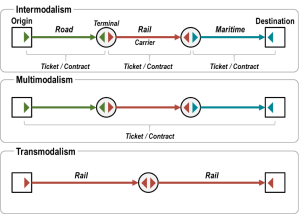Table of Contents
What is intermodal transport?
Intermodal transport is the movement of goods or passengers from one mode of transport to another, usually by transhipment at a specific terminal.

In the image above, we can see that intermodality is divided into four main functions:
- Composition (first mile)
- Connection (transfer)
- Interchange
- Decomposition (last mile)
How did intermodal transport as we know it today originate?
The beginning of intermodality can be traced back to 1960, where what started as an efficiency improvement in maritime trade eventually resulted in the formation of fully integrated supply chains. Two things were key to this: the development of the world economy towards large-scale globalisation and the containerization. Intermodality requires standardisation and the container was the foundation for forming integrated intermodal systems.
Although the beginnings of intermodality started in the 1960s, it was not until the 1980s that it really became possible thanks to: the improvement of terminal systems, with a clear increase in efficiency, and the deregulation of the sector, especially in the United States. The ban on companies owning multiple modes was lifted, which encouraged cooperation between companies towards intermodal systems. Mainly shipping companies started to offer integrated services via rail and road to their customers. Thanks to this, customers could buy transport services without worrying about modal barriers, there was a great simplification of the famous ‘Bill of Landing’, meaning a clear standardisation of processes.
Multimodal vs. Intermodal
The difference is the type of contract. While in multimodal transport there is only one contract with one company, in intermodal transport the customer will find several transport providers. For example, the shipping company (which takes care of the port to port) and the 3PL provider which takes care of the first and last mile.
This does not mean that multimodal is the owner of all the means of transport but the one responsible for each of them. The customer is only associated with one entity that is responsible for the coordination of all means of transport.

What are the characteristics necessary to develop an intermodal transport network?
- The nature and quatity of the transported cargo
- The modes of transport which take part.
- The origins and destinations.
- Transportation time and costs.
- The value of the load.
- The frequency of shipments.
References:
Comtois. C, Slack. B & Rodrigue, Jean-Paul (2017). The Geography of transport systems. New York: Routledge
Cullinale, K. and M. Khanna (2000) ‘’Economies of scale in large containerships.’’ Journal of Transport Economics and Policy 33: 185-207.
Levinson, M. (2006) The Box: How the shipping Container Made the World Smaller and the World Economy Bigger. Princenton: Princenton University Press.
